
The Ricoh CX1 has been introduced by Ricoh in 2009. This is the first Ricoh camera to use a CMOS sensor. It allows it to operate at four frames/sec and perform hi-speed continuous shooting.

The Ricoh CX1 has been introduced by Ricoh in 2009. This is the first Ricoh camera to use a CMOS sensor. It allows it to operate at four frames/sec and perform hi-speed continuous shooting.
The Ricoh CX1 received a mainly favourable reception from independent reviewers.
Best4Reviews.com said that the CX1 was
"a highly specified, well crafted camera with a host of very clever features that really work. The Ricoh CX1 is however a machine for the more advanced user and offers image quality to match, for those that know what they’re doing." [2]
IT Reviews concluded that:
"Ricoh has managed to pack a lot under the stylish hood of the CX1, including some welcome new features like very high-speed continuous shooting and increased dynamic range, plus multi-targeting AF and WB." [3]

A digital camera is a camera that captures photographs in digital memory. Most cameras produced today are digital, largely replacing those that capture images on photographic film. Digital cameras are now widely incorporated into mobile devices like smartphones with the same or more capabilities and features of dedicated cameras. While there are still dedicated digital cameras, many more cameras are now incorporated into mobile devices like smartphones. High-end, high-definition dedicated cameras are still commonly used by professionals and those who desire to take higher-quality photographs.
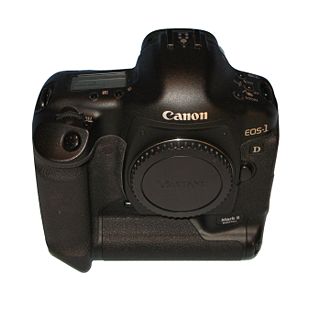
The EOS 1D Mark II is a professional 8.2 megapixel digital single lens reflex camera (DSLR) camera body produced by Canon. The EOS 1D Mark II was the successor of the EOS 1D and was itself replaced by the Canon EOS-1D Mark III in 2007. It was Canon's first dual-card slot EOS camera with one CF slot and one SD slot that was meant easily to use two dominant card types and have a assurance that once a small sized primary and faster CF slot is full, camera can be used to take photographs when recording was continued on secondary and slower card in critical moment. It also now had wireless capabilities. When paired with the new Canon WFT-E1, you could transfer images to a PC using an FTP server.

The Canon EOS 5D is a 12.8 megapixel digital single-lens reflex (DSLR) camera body produced by Canon. The EOS 5D was announced by Canon on 22 August 2005, and at the time was priced above the EOS 20D but below the EOS-1D Mark II and EOS-1Ds Mark II in Canon's EOS digital SLR series. The camera accepts EF lens mount lenses.
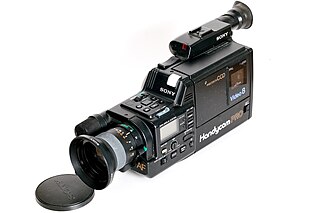
Sony Corporation produces professional, consumer, and prosumer camcorders such as studio and broadcast, digital cinema cameras, camcorders, pan-tilt-zoom and remote cameras.

The EOS 1D Mark III is a professional 10.1 megapixel digital single lens reflex camera (DSLR) camera body produced by Canon. The EOS 1D Mark III was announced on February 21, 2007 and is the successor of the Canon EOS-1D Mark II N and was first released in May 2007. In late 2009, the camera was succeeded by the Canon EOS-1D Mark IV. One of the main benefits of the new Mark III, over the previous models, was the added functionality of Live view, allowing users to take pictures while looking at an LCD screen. While it had the same outdated software as the older 1D series cameras, it had a much improved button layout, which is still used today. It also had improved wireless capabilities over the Mark II. The new WFT-E2 was much smaller than the previous WFT-E1 for the Mark II. The new transmitter could now also connect via a USB port. This allowed the optional addition of a GPS unit and wired PC connectivity.

The Pentax K20D and its clone, the Samsung GX-20, are 14.6 megapixel digital single-lens reflex cameras manufactured by Pentax that were announced on January 23, 2008. The K20D was available in the U.S. market from February 2008 through autumn 2009.

The Nikon D700 is a professional-grade full-frame digital single-lens reflex camera introduced by the Nikon Corporation in July 2008 and manufactured in Japan. It uses the same 12.1-megapixel "FX" CMOS image sensor as the Nikon D3, and is Nikon's second full-frame digital SLR camera.

The Canon EOS 50D is a 15.1-megapixel digital single-lens reflex camera. It is part of the Canon EOS line of cameras, succeeding the EOS 40D and preceding the EOS 60D.

The Nikon D90 is a 12.3 megapixel digital single-lens reflex camera (DSLR) model announced by Nikon on August 27, 2008. It is a prosumer model that replaces the Nikon D80, fitting between the company's entry-level and professional DSLR models. It has a Nikon DX format crop sensor.

The Canon EOS 500D is a 15-megapixel entry-level digital single-lens reflex camera, announced by Canon on 25 March 2009. It was released in May 2009. It is known as the EOS Kiss X3 in Japan, and as the EOS Rebel T1i in North America. It continues the Rebel line of mid-range DSLR cameras, is placed by Canon as the next model up from the EOS 450D, and has been superseded by the EOS 550D (T2i).
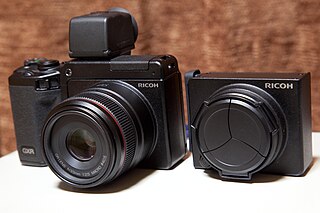
The Ricoh GXR is a compact digital camera first announced by Ricoh Company, Ltd, Tokyo on November 10, 2009. Unlike conventional cameras which either have a fixed lens and sensor or interchangeable lens and a fixed sensor, the GXR takes interchangeable units, each housing a lens, sensor and image processing engine. This allows each unit to have these features optimised to one another and a specific task, whereas with conventional interchangeable lens cameras, each different lens must use the same sensor and engine. The sealed units also prevent dust from reaching the sensor, which can be a problem with other cameras where the sensor is exposed whilst a lens is being changed. A significant disadvantage of this system is the extra cost involved in having to buy a whole new sensor with every new lens.

The Nikon 1 J1 is a Nikon 1 series high-speed mirrorless interchangeable-lens camera with 1" sensor size launched by Nikon on September 21, 2011. It is a new model that focuses on high-performance, portability and versatility. Nikon lists the estimated selling price of the Nikon 1 J1 One-Lens Kit in the United States at $649.95. Released on October 20, 2011, this kit comes with the 1 NIKKOR VR 10-30mm f/3.5-5.6 lens.
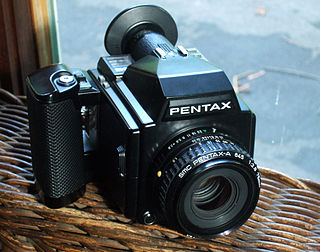
The Pentax 645 is a medium format single-lens reflex system camera manufactured by Pentax. It was introduced in 1984, along with a complementary line of lenses. It captures images nominally 6 cm × 4.5 cm on 120, 220, and 70 mm film, though the actual size of the images is 56 mm × 41.5 mm.
The Nikon 1 S1 is a Nikon 1 series low-cost high-speed mirrorless interchangeable-lens camera launched by Nikon. Nikon lists the estimated selling price of the Nikon 1 S1 One-Lens Kit in the United States at $499.95. This kit comes with the 1 NIKKOR 11–27.5mm f/3.5-5.6 lens. It features many similarities with the 1 J2, like the same 10.1 megapixel CX-format CMOS sensor and autofocus, but with an upgraded EXPEED 3A processor.
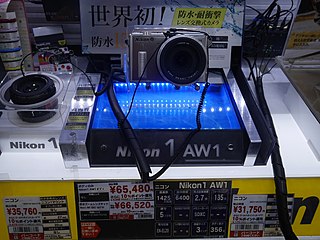
The Nikon 1 AW1 is a Nikon 1 series high-speed mirrorless interchangeable-lens camera by Nikon. It is a waterproof, rugged, high-speed MILC camera with 15 metres (49 ft) water pressure resistance, shockproof from 2 metres (6.6 ft), and freezeproof to −10 °C (14 °F). It was announced on September 19, 2013, together with two waterproof lenses.

The Ricoh GR is a digital large sensor compact camera announced by Ricoh on April 17, 2013, one of a number of Ricoh GR digital cameras. It was succeeded by the Ricoh GR II in 2015 and the Ricoh GR III in 2019.

The Canon EOS 7D Mark II is a professional digital single-lens reflex camera made by Canon. It was announced on September 15, 2014 with a suggested retail price of US$1,799. It features a 20.2 effective megapixel APS-C CMOS sensor, Full HD video recording at 60 fps, 10.0 frames per second continuous shooting, a 100% accuracy viewfinder that offers 1× magnification. It also features a 65-point auto-focus system, a built-in Speedlite transmitter and a new 150k RGB pixels + IR metering sensor. It was preceded by the Canon EOS 7D.

The Canon EOS 6D Mark II is a 26.2-megapixel full-frame digital single-lens reflex camera announced by Canon on June 29, 2017.

The Fujifilm X-T3 is a mirrorless interchangeable-lens digital camera announced on September 6, 2018. It is weather-resistant, has a backside-illuminated X-Trans CMOS 4 APS-C sensor and an X-Processor 4 quad core processor. It is the successor to 2016's Fujifilm X-T2. It uses the Fujifilm X-mount.

The Fujifilm X-T4 is a mirrorless interchangeable-lens digital camera announced on February 25, 2020. It has a backside-illuminated X-Trans CMOS 4 APS-C sensor and an X-Processor 4 quad core processor and uses the Fujifilm X-mount. The X-T4 is a weather-resistant camera equipped with a higher-capacity battery designed to last longer than the X-T3. It is the successor to 2018's X-T3, which is a little larger and heavier.